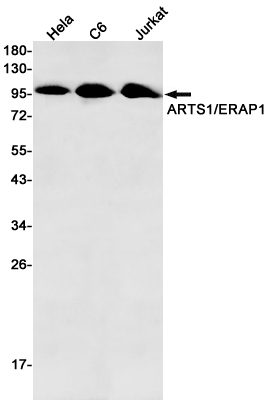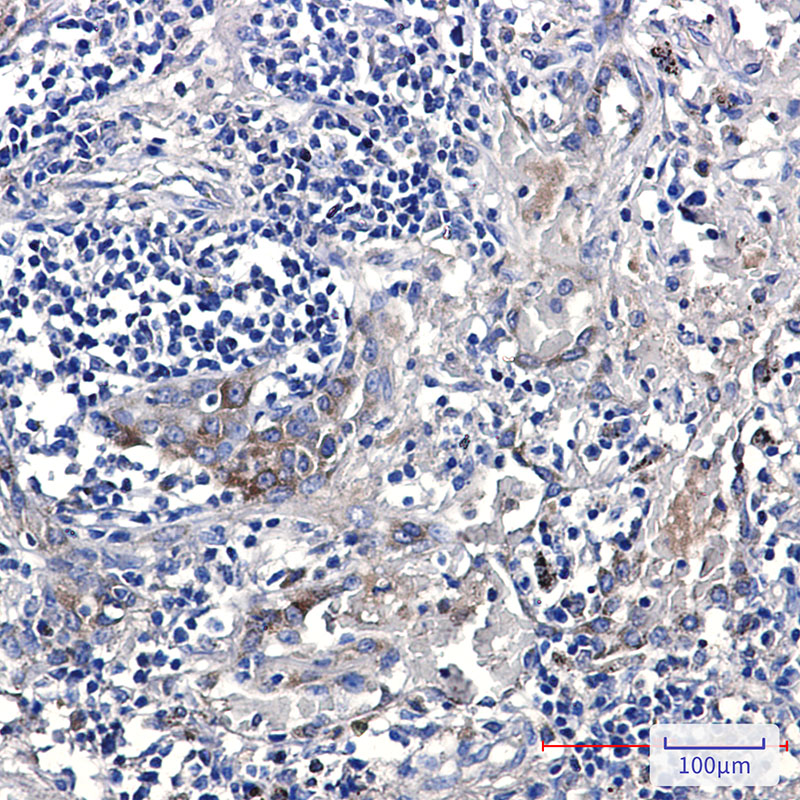

| WB | 咨询技术 | Human,Mouse,Rat |
| IF | 咨询技术 | Human,Mouse,Rat |
| IHC | 1/50-1/100 | Human,Mouse,Rat |
| ICC | 技术咨询 | Human,Mouse,Rat |
| FCM | 咨询技术 | Human,Mouse,Rat |
| Elisa | 咨询技术 | Human,Mouse,Rat |
| Aliases | ERAP1; APPILS; ARTS1; KIAA0525; Endoplasmic reticulum aminopeptidase 1; ARTS-1; Adipocyte-derived leucine aminopeptidase; A-LAP; Aminopeptidase PILS; Puromycin-insensitive leucyl-specific aminopeptidase; PILS-AP; Type 1 tumor necrosis facto |
| Entrez GeneID | 51752 |
| WB Predicted band size | Calculated MW: 107 kDa; Observed MW: 107 kDa |
| Host/Isotype | Rabbit IgG |
| Antibody Type | Primary antibody |
| Storage | Store at 4°C short term. Aliquot and store at -20°C long term. Avoid freeze/thaw cycles. |
| Species Reactivity | Human,Rat |
| Immunogen | A synthetic peptide of human ARTS1 |
| Formulation | Purified antibody in TBS with 0.05% sodium azide,0.05%BSA and 50% glycerol. |
+ +
以下是关于 **ERAP1抗体** 的3篇参考文献及其摘要概括:
---
1. **文献名称**: *Structural basis for antigenic peptide precursor processing by human ERAP1*
**作者**: Kochan G, et al.
**摘要**: 该研究通过X射线晶体学解析了ERAP1的酶活性结构,揭示了其如何选择性剪切抗原肽前体以适配MHC I类分子,为开发靶向ERAP1的抗体或抑制剂提供了结构基础。
---
2. **文献名称**: *ERAP1 regulates natural killer cell function by processing the NKG2D ligand ULBP1*
**作者**: Cifaldi L, et al.
**摘要**: 研究发现ERAP1通过剪切ULBP1蛋白调控NK细胞的免疫识别功能,使用ERAP1特异性抗体阻断其活性可增强NK细胞对肿瘤细胞的杀伤能力,提示其在癌症免疫治疗中的潜在应用。
---
3. **文献名称**: *Autoimmune disease-associated variants of ERAP1 shape the peptidome of HLA-B27 allotypes*
**作者**: Reeves E, et al.
**摘要**: 该文献通过抗体标记和质谱分析,证明ERAP1基因多态性(如与强直性脊柱炎相关突变)影响其剪切HLA-B27结合肽的能力,导致自身免疫性疾病中异常抗原呈递。
---
如需具体实验抗体品牌或应用文献,可进一步补充说明研究方向(如疾病模型、检测方法等)。
ERAP1 (Endoplasmic Reticulum Aminopeptidase 1) is a key enzyme involved in antigen processing and presentation, primarily functioning within the endoplasmic reticulum. As a member of the M1 zinc metallopeptidase family, it trims peptides to optimal lengths for loading onto major histocompatibility complex (MHC) class I molecules, a critical step in adaptive immune responses. ERAP1’s activity influences the repertoire of antigens presented to cytotoxic T cells, thereby modulating immune surveillance and autoimmune susceptibility. Genetic studies have linked ERAP1 polymorphisms to autoimmune diseases like ankylosing spondylitis, psoriasis, and inflammatory bowel disease, particularly in individuals carrying HLA-B27 variants.
ERAP1-specific antibodies are valuable tools for studying its expression, localization, and functional roles. They enable detection via techniques like Western blotting, immunohistochemistry, or flow cytometry, aiding research into ERAP1’s regulation and interaction with other antigen-processing components. Additionally, ERAP1 is explored as a therapeutic target; antibodies blocking its activity may alter antigen presentation to mitigate autoimmune responses or enhance cancer immunotherapy by modifying tumor antigen visibility. Recent studies also suggest ERAP1’s involvement in angiogenesis and blood pressure regulation, expanding its relevance beyond immunology. However, its dual roles in immune activation and tolerance require careful investigation to avoid unintended effects in therapeutic applications.
×